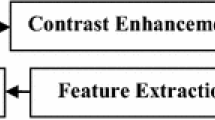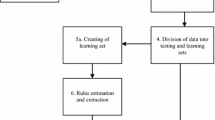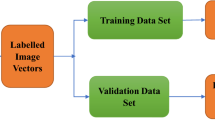Abstract
Weld quality management is currently one of the most concerning issues in the manufacturing industry. In this paper, a novel method is proposed for weld defect classification based on the analytical hierarchy process (AHP) and Dempster–Shafer (DS) evidence theory. First, to overcome the problem of traditional DS methods, which weigh every feature equally in classification, a method is proposed based on AHP to calculate the weight of features (WF) of a weld defect, which can then be utilized in classification. Then, an improved method based on DS evidence theory is presented to improve the accuracy of classification, which includes calculation of the standard value of features based on frequency histograms analysis and an improved Dempster’s rule for combination based on WF. A case study on the classification of steam turbine weld defects is provided to illustrate and evaluate the proposed techniques. The results show that the proposed method increases the correct recognition rate of classification with limited samples, making DS evidence theory applicable to weld defect classification.





Similar content being viewed by others
References
da Silva, R. R., & Mery, D. (2007a). The state of the art of weld seam radiographic testing: Part I–image processing. Materials Evaluation, 65(6), 643–647.
da Silva, R. R., & Mery, D. (2007b). The state of the art of weld seam radiographic testing: Part II–pattern recognition. Materials Evaluation, 65(9), 833–838.
Dempster, A. P. (1968). A generalization of Bayesian inference. Journal of the Royal Statistical Society: Series B (Methodology), 30(2), 205–247.
Dudewicz, E. J. (1999). Basic statistical methods. In J. M. Juran & A. B. Godfrey (Eds.), Juran’s quality handbook (5th ed., pp. 44.1–44.112). New York: McGraw-Hill.
Du, X., Shen, Y., & Wang, Y. (2008). Weld defect classification in ultrasonic testing basing on time-frequency discriminant features. Transactions-China Welding Institution, 29(2), 89–92.
Fan, M., Wei, L., He, Z., Wei, W., & Lu, X. (2016). Defect inspection of solder bumps using the scanning acoustic microscopy and fuzzy SVM algorithm. Microelectronics Reliability, 65, 192–197. https://doi.org/10.1016/j.microrel.2016.08.010.
Gao, H., Shen, X., Jiang, Z., Yang, H., & Yan, L. (2012). Image subcategory classification based on Dempster–Shafer evidence theory. In International Conference on Computer Science and Service System (pp. 2289–2292). Nanjing: CHN, August 11–13, 2012. https://doi.org/10.1109/CSSS.2012.568
Gao, W., & Hu, Y. H. (2014). Real-time X-ray radiography for defect detection in submerged arc welding and segmentation using sparse signal representation. Insight-Non-Destructive Testing and Condition Monitoring, 56(6), 299–307. https://doi.org/10.1784/insi.2014.56.6.299.
Gu, K., Zhai, G., Yang, X., & Zhang, W. (2013). A new reduced-reference image quality assessment using structural degradation model. In 2013 IEEE international symposium on circuits and systems (ISCAS). (pp. 1095–1098). Beijing: CHN, May 19–23, 2013. https://doi.org/10.1109/ISCAS.2013.6572041.
Hafizan, C., Noor, Z. Z., Abba, A. H., & Hussein, N. (2016). An alternative aggregation method for a life cycle impact assessment using an analytical hierarchy process. Journal of Cleaner Production, 112(4), 3244–3255. https://doi.org/10.1016/j.jclepro.2015.09.140.
Han, D., Yang, Y., & Han, C. (2014). Advances in DS evidence theory and related discussions. Control and Decision, 29(1), 1–11. https://doi.org/10.13195/j.kzyjc.2013.0517.
Hong, S. J., Lim, W. Y., Cheong, T., & May, G. S. (2012). Fault detection and classification in plasma etch equipment for semiconductor manufacturing \(e\)-diagnostics. IEEE Transactions on Semiconductor Manufacturing, 25(1), 83–93. https://doi.org/10.1109/TSM.2011.2175394.
Jiang, H., Liang, Z., Gao, J., & Dang, C. (2016). Classification of weld defect based on information fusion technology for radiographic testing system. Review of Scientific Instruments, 87(3), 035110. https://doi.org/10.1063/1.4943220.
Li, T.-S. (2009). Applying wavelets transform, rough set theory and support vector machine for copper clad laminate defects classification. Expert systems with Applications, 36(3 Pt 2), 5822–5829. https://doi.org/10.1016/j.eswa.2008.07.040.
Liao, T. W. (2003). Classification of welding flaw types with fuzzy expert systems. Expert Systems with Applications, 25(1), 101–111. https://doi.org/10.1016/S0957-4174(03)00010-1.
Liao, T. W. (2009). Improving the accuracy of computer-aided radiographic weld inspection by feature selection. NDT & E International, 42(4), 229–239. https://doi.org/10.1016/j.ndteint.2008.11.002.
Lim, T. Y., Ratnam, M. M., & Khalid, M. A. (2007). Automatic classification of weld defects using simulated data and an MLP neural network. Insight-Non-Destructive Testing and Condition Monitoring, 49(3), 154–159. https://doi.org/10.1784/insi.2007.49.3.154.
Liu, H., Chen, Y., Peng, X., & Xie, J. (2011). A classification method of glass defect based on multiresolution and information fusion. The International Journal of Advanced Manufacturing Technology, 56(9–12), 1079–1090. https://doi.org/10.1007/s00170-011-3248-z.
Maruthur, N. M., Joy, S., Dolan, J., Segal, J. B., Shihab, H. M., & Singh, S. (2013). Systematic assessment of benefits and risks: Study protocol for a multi-criteria decision analysis using the analytic hierarchy process for comparative effectiveness research. F1000Research, 2, 160. https://doi.org/10.12688/f1000research.2-160.v1
Movafeghi, A. (2015). Using empirical mode decomposition and a fuzzy algorithm for the analysis of weld defect images. Insight-Non-Destructive Testing and Condition Monitoring, 57(1), 35–39. https://doi.org/10.1784/insi.2014.57.1.35.
Mu, W., Gao, J., Jiang, H., Wang, Z., Chen, F., & Dang, C. (2013). Automatic classification of weld defects based on optimal PCA and SVM. Insight-Non-Destructive Testing and Condition Monitoring, 55(10), 535–539. https://doi.org/10.1784/insi.2012.55.10.535.
Mu, W., Gao, J., Wang, Z., Jiang, H., Chen, F., & Dang, C. (2013). Radiographic image assessment approach based on human visual system. Journal of Xi’an Jiaotong University, 47(7), 91–95.
Nacereddine, N., Hamami, L., & Ziou, D. (2006). Thresholding techniques and their performance evaluation for weld defect detection in radiographic testing. International Journal of Machine Graphics and Vision, 15(3), 557–566.
Nacereddine, N., Ziou, D., & Hamami, L. (2013). Fusion-based shape descriptor for weld defect radiographic image retrieval. The International Journal of Advanced Manufacturing Technology, 68(9–12), 2815–2832. https://doi.org/10.1007/s00170-013-4857-5.
Pan, J., Jiang, H., Gao, J., & Yang, P. (2011). Condition diagnosis with complex network-time series analysis. In Proceedings of Annual Reliability and Maintainability Symposium, Lake Buena Vista, FL, USA (pp. 1–6), January 24–27, 2011. https://doi.org/10.1109/RAMS.2011.5754502.
Pohl, C., & Van Genderen, J. L. (1998). Multisensor image fusion in remote sensing: Concepts, methods and applications. International Journal of Remote Sensing, 19(5), 823–854. https://doi.org/10.1080/014311698215748.
Saaty, T. L. (1980). The analytic hierarchy process. New York: McGraw-Hill.
Saaty, T. L. (1990). How to make a decision: The analytic hierarchy process. European Journal of Operational Research, 48(1), 9–26. https://doi.org/10.1016/0377-2217(90)90057-I.
Salchak, Y., Tverdokhlebova, T., Sharavina, S., & Lider, A. (2016). The classification of weld seam defects for quantitative analysis by means of ultrasonic testing. IOP Conference Series: Materials Science and Engineering, 132, 012027. https://doi.org/10.1088/1757-899X/132/1/012027.
Shafer, G. (1976). A mathematical theory of evidence. Princeton: Princeton University Press.
Shen, Q., & Gao, J. (2010). Improving the classification accuracy of the weld defect by chaos-search-based feature selection. Insight-Non-Destructive Testing and Condition Monitoring, 52(10), 530–539. https://doi.org/10.1784/insi.2010.52.10.530.
Shen, Q., Gao, J., & Li, C. (2010). Automatic classification of weld defects in radiographic images. Insight-Non-Destructive Testing and Condition Monitoring, 52(3), 1–6. https://doi.org/10.1784/insi.2010.52.3.134.
Sreedhar, U., Krishnamurthy, C. V., Balasubramaniam, K., Raghupathy, V. D., & Ravisankar, S. (2012). Automatic defect identification using thermal image analysis for online weld quality monitoring. Journal of Materials Processing Technology, 212(7), 1557–1566. https://doi.org/10.1016/j.jmatprotec.2012.03.002.
Wang, G., & Liao, T. W. (2002). Automatic identification of different types of welding defects in radiographic images. NDT & E International, 35(8), 519–528. https://doi.org/10.1016/S0963-8695(02)00025-7.
You, D., Gao, X., & Katayama, S. (2015). WPD-PCA-based laser welding process monitoring and defects diagnosis by using FNN and SVM. IEEE Transactions on Industrial Electronics, 62(1), 628–636. https://doi.org/10.1109/TIE.2014.2319216.
Zahran, O., & Al-Nuaimy, W. (2002). Recent developments in ultrasonic techniques for rail-track inspection. In Proceedings of the Annual Conference of the British Institute of Non-destructive Testing (BINDT 2002) (pp. 55–60). Southport: GBR, September 17–19, 2002.
Zahran, O., Kasban, H., EI-Kordy, M., & Abd El-Samie, F. E. (2013). Automatic weld defect identification from radiographic images. NDT & E International, 57, 26–35. https://doi.org/10.1016/j.ndteint.2012.11.005.
Zapata, J., Vilar, R., & Ruiz, R. (2010). An adaptive-network-based fuzzy inference system for classification of welding defects. NDT & E International, 43(3), 191–199. https://doi.org/10.1016/j.ndteint.2009.11.002.
Zapata, J., Vilar, R., & Ruiz, R. (2012). Automatic inspection system of welding radiographic images based on ANN under a regularisation process. Journal of Nondestructive Evaluation, 31(1), 34–45. https://doi.org/10.1007/s10921-011-0118-4.
Zhang, X., Zhu, Z., Xu, J., & Ren, S. (2005). The classification algorithm of defects in weld image based on asymmetrical SVMs. In International Conference on Control Automation 2005 (ICCA ’05) (pp. 1215–1219). Budapest: HUN, June 26–29, 2005. https://doi.org/10.1109/ICCA.2005.1528306
Zhu, P., Yin, C., Cheng, Y., Huang, X., Cao, J., Vong, C.-M., et al. (2017). An improved feature extraction algorithm for automatic defect identification based on eddy current pulsed thermography. Mechanical Systems and Signal Processing. https://doi.org/10.1016/j.ymssp.2017.02.045.
Acknowledgements
The authors sincerely thank the referees for their helpful suggestions and comments, which greatly improved the quality of the paper. This research was supported by the National Natural Science Foundation of China (Grant No. 51375375).
Author information
Authors and Affiliations
Corresponding author
Rights and permissions
About this article
Cite this article
Jiang, H., Wang, R., Gao, Z. et al. Classification of weld defects based on the analytical hierarchy process and Dempster–Shafer evidence theory. J Intell Manuf 30, 2013–2024 (2019). https://doi.org/10.1007/s10845-017-1369-4
Received:
Accepted:
Published:
Issue Date:
DOI: https://doi.org/10.1007/s10845-017-1369-4




